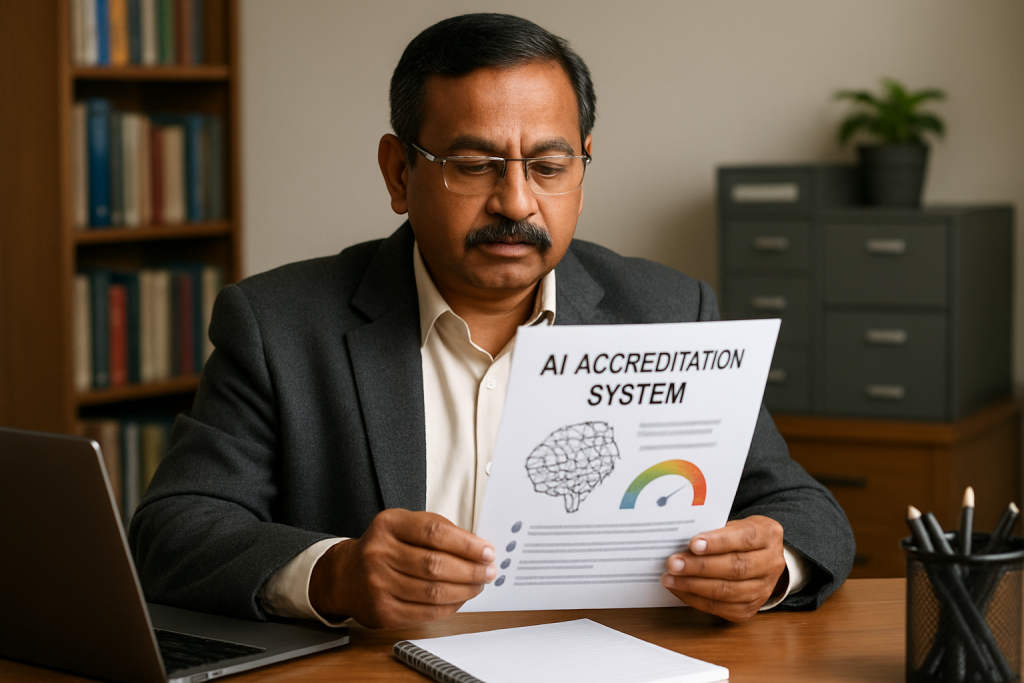India’s higher education sector is getting a major digital upgrade. The National Assessment and Accreditation Council (NAAC) will launch an AI-powered accreditation system in August. This marks the biggest change to university accreditation in three decades.
The new system targets ambitious growth. Currently, only 40% of Indian universities hold NAAC accreditation. Just 18% of colleges are accredited. Professor Anil Sahasrabudhe, NAAC Chairperson, wants over 90% participation within five years.
Why It Matters Now
The traditional seven-point grading system is gone. Universities now get a simple binary result: ‘Accredited’ or ‘Not Accredited’. This removes complexity and speeds up the NAAC accreditation process.
Physical peer reviews made up 30% of old assessments. These visits often caused delays and credibility concerns. The new system eliminates site visits for basic accreditation. Everything moves to digital verification through AI databases.
Education technology companies will find new opportunities here. The shift creates demand for data management systems, verification tools, and compliance software utilized in an AI education system.
How It Solves a Key Problem
The old system had serious flaws. Peer visits were slow and sometimes unreliable. Institutions complained about manipulation and lack of transparency. The AI approach addresses these issues directly.
A rotating panel of 100 stakeholders now reviews submissions. This includes vice-chancellors, faculty, NGO representatives, and industry experts. Their feedback creates a credibility score between 0 and 1 in the digital verification process.
Each institution starts with a base score of 0.5. The score adjusts based on document accuracy. False submissions trigger penalties. Confirmed misconduct leads to a three-year ban from university accreditation.
The AI also monitors reviewer reliability. This ensures fair and impartial assessments throughout the process.
Strategic Advantage for Business Leaders
The two-tier system creates clear pathways for growth. Basic accreditation serves all institutions. Maturity-based graded accreditation offers advanced recognition for ambitious schools.
Institutions with existing A, A+, or A++ grades can choose their path. They can opt for basic accreditation or apply directly for higher maturity levels.
The maturity-based system has five levels. Universities need 55 indicators at Level 1. Requirements increase to 80-100 parameters at Level 5, emphasizing continuous improvement within the higher education AI framework.
Physical site visits return from Level 3 onwards. These follow a hybrid format combining online and on-site evaluations. This maintains transparency while reducing manipulation risks.
What Business Leaders Should Know
Foreign institutions with Indian campuses can now seek NAAC accreditation. This opens doors for international education partnerships and joint ventures in the higher education AI landscape.
The changes align with National Education Policy (NEP) 2020 goals. This signals government commitment to education sector transformation.
Nandan Nilekani, Chairman said: “While embracing AI will bring a goldmine of opportunities, it will not be entirely without some foreseeable risks. Regulatory variances across regions will need to be incorporated into one’s strategy. The early learnings from enterprise AI adoption give us a glimpse of these potential challenges that lie on the path ahead. Our AI work spans a wide spectrum of priority areas like process improvement, engineering, customer service, cybersecurity, and employee productivity. We have built four small language models for banking, IT operations, cyber and enterprises broadly.”
Market Impact in India
The reforms create immediate business opportunities. Education technology companies can develop specialized tools for the NAAC accreditation system. Compliance software providers will see increased demand.
Data verification and management services become essential. Institutions need help preparing digital submissions and maintaining credibility scores under the new university accreditation process.
Consulting firms can guide institutions through the transition. Training programs for the new system will be valuable.
Implementation Timeline
The system launches in August 2025. Institutions should prepare now by organizing their documentation. Digital readiness becomes a competitive advantage in the higher education AI sector.
Professor Sahasrabudhe emphasizes voluntary participation. “Our goal is to encourage institutions to voluntarily participate and strive for higher standards,” he said.
The reforms stem from recommendations by a committee led by former ISRO chief Dr K Radhakrishnan. This high-level backing ensures sustained government support.
This transformation represents more than technology adoption. It signals India’s commitment to transparent, efficient education standards. Business leaders in education should start preparing for this digital future now.


